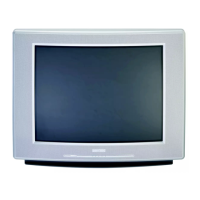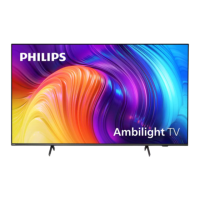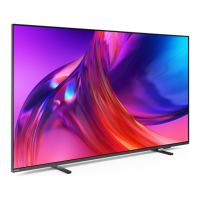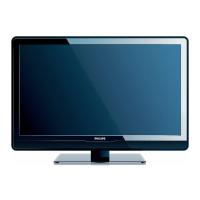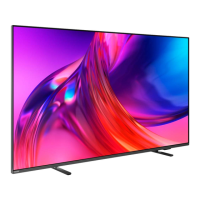
Do you have a question about the Philips 8518 Series and is the answer not in the manual?
Explains the purpose and features of the Home screen.
Describes the side panel for settings and device controls.
Differentiates between Google TV and Basic mode features.
Provides steps to open and navigate the Home screen.
Advises to read safety instructions before use.
Details on installing the TV stand and wall mounting.
Recommendations for optimal TV placement and viewing distance.
Instructions for connecting the power cable.
Guidance on connecting the antenna cable.
Instructions for connecting a satellite dish.
Details the functions of each key on the remote control.
Explains the Bluetooth pairing process for the remote.
How to use voice search with the remote.
Instructions for replacing batteries and cleaning the remote.
Steps to turn the TV on, off, or put it in standby.
Basic TV operations using the TV's physical keys.
Guide for installing satellite channels and settings.
Procedures for antenna channel installation and updates.
Instructions for copying and uploading channel lists via USB.
General information on installing channels.
Explains how channel lists are displayed and managed.
How to filter and sort channel lists.
How to tune, switch, and lock channels.
Setting preferred and selecting subtitle languages.
How to enable subtitles from broadcast or text.
Setting preferred and selecting audio languages.
Features for users with disabilities (text, speech, shortcuts).
Settings for HbbTV and operator apps.
Creating and managing lists of favorite channels.
Adding consecutive channels to a Favourites List.
Renaming a Favourites List using the on-screen keyboard.
Removing a Favourites List from the TV.
Changing the sequence of channels within a Favourites List.
How to use Text/Teletext pages and subpages.
Features and language settings for Teletext.
Using interactive TV features like HbbTV.
Information on viewing current and scheduled TV programs.
How to open, navigate, and tune programs in the TV Guide.
Guide to connecting devices using quality cables.
Details on HDMI port quality and HDCP copy protection.
Using EasyLink for controlling HDMI CEC devices.
Adjusting HDMI Ultra HD settings for compatibility.
Connecting HTS via HDMI ARC/eARC and troubleshooting sound.
Using optical audio output for sound connection.
Using CI+ module and smart card for premium programs.
Connecting mobile devices via Philips TV Remote App.
Connecting a Blu-ray player using HDMI.
Connecting headphones and adjusting volume.
Connecting a game console via HDMI for optimal quality.
Connecting and installing a USB keyboard for text input.
Viewing content from USB storage devices.
Connecting digital cameras via USB to view photos.
Connecting camcorders via HDMI for viewing.
Connecting a computer via HDMI to use TV as a monitor.
Setting up home network and internet connection.
Configuring network, Wi-Fi, Chromecast, and DMR.
Signing into Google Account for full TV capabilities.
How to launch and use the TV's web browser.
How to switch between connected TV sources and devices.
Accessing TV functions and settings quickly.
Adjusting picture settings like style, brightness, contrast.
Advanced picture adjustments for contrast, brightness, and HDR.
Adjusting colour, sharpness, and texture settings.
Features for noise reduction and motion smoothness.
Adjusting motion smoothness and using quick picture setup.
Adjusting picture aspect ratio and motion clarity.
Adjusting sound styles, equalizer, and dialogue.
Setting up DTS Play-Fi and personalizing sound with Mimi.
Controlling HDMI sound system via EasyLink 2.0.
Selecting sound styles, adjusting bass, treble, and equalizer.
Configuring surround sound effects and calibrating room acoustics.
Setting TV sound output to speakers or audio systems.
Turning Ambilight on/off and setting styles.
Setting custom colours and team-specific lighting.
Using Ambisleep for relaxation and adjusting brightness.
Using lounge light mode and extending Ambilight to speakers.
Adjusting Ambilight brightness, saturation, and wall colour influence.
Using Sunrise Alarm and Aurora App for ambiance.
Overview of apps, installation, and uninstallation.
Renting/buying movies/TV shows and using Google Play.
Playing games and making payments via Google Play.
Installing apps and setting parental controls in Play Store.
How to launch and close apps on the TV.
Managing installed apps, cache, and permissions.
Features for users with disabilities (text, speech, shortcuts).
Information about system software updates.
Options for resetting TV settings and reinstalling.
Setting automatic/manual date, time, and time zone.
Changing the TV menu and message language.
Setting keyboard layout for USB keyboards.
Checking internal storage usage for apps and media.
Configuring screen saver settings and display options.
Settings for power behavior and energy saving.
Settings for screen off, auto standby, and switch off timers.
Casting content from mobile devices using Google Cast.
Enabling or disabling system sounds.
Setting and changing the child lock code.
Setting parental rating and locking programs.
Configuring TV for retail or shop display modes.
Instructions for restarting the TV to improve performance.
Pairing, connecting, disconnecting, and managing Bluetooth devices.
Pairing and managing the remote control.
Checking for and updating remote control software.
Viewing media files from a network computer or NAS.
Adding and viewing favorite files and folders.
Viewing popular and recently played media files.
Viewing media files from a connected USB drive.
Opening video folders and playing video files.
Opening and viewing photo folders and individual photos.
Adjusting photo display and viewing 360 photos.
Opening music folders and playing music files.
Using the Philips TV Remote App for control.
Requirements for playing games on the TV.
Connecting and using wireless gamepads.
Connecting consoles/PCs to play games.
Using the gaming control bar for game settings.
Enabling Spatial Audio for Netflix content.
Overview of Alexa voice control features and requirements.
Setup process for using Alexa voice commands.
Information on energy efficiency and disposal.
Technical power specifications and saving features.
Details of the TV's operating system.
Information on TV tuner and reception capabilities.
Screen size options for the TV.
Supported video and computer input resolutions.
List of available TV ports and connections.
Audio output power and sound technologies.
Supported file formats and codecs for media playback.
Benefits and process of registering the TV.
Accessing the TV's help system and manual.
Running diagnostic tests for TV issues.
Checking TV, network, remote control, storage, and apps.
Solutions for common TV issues like power, sound, and picture.
Resolving issues with HDMI, USB, and network connections.
Accessing Philips support website for help.
Contacting customer care for support and repairs.
Important safety instructions for using the TV.
Warnings about electric shock, injury, stability, batteries, heat, and environment.
Instructions for cleaning and maintaining the TV screen.
General terms of use for the TV product.
Details on pixel/backlight characteristics and regulatory compliance.
Terms of use, privacy policy, and privacy settings for Smart TV.
Copyright information for Google TV.
Copyright and trademark information for HDMI.
Patent information for HEVC Advance.
Trademark information for AMD FreeSync Premium.
Copyright and trademark info for Dolby technologies.
Trademark and patent information for DTS:X.
Trademark and patent info for DTS Play-Fi.
Trademark for Wi-Fi Alliance.
Trademark for Kensington security products.
General information on other trademarks.


